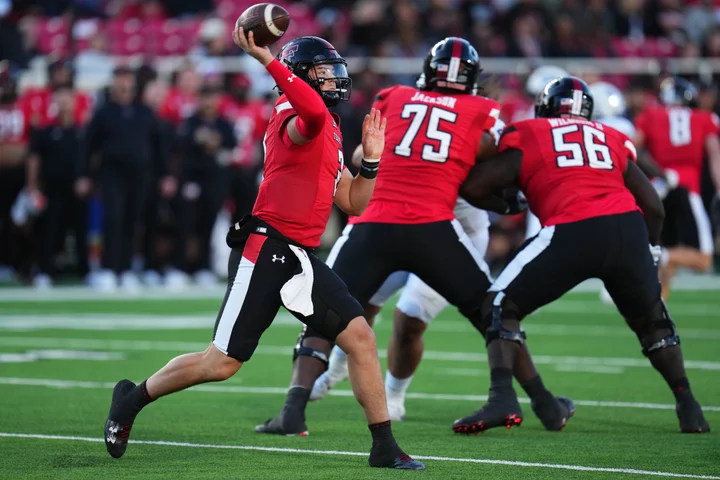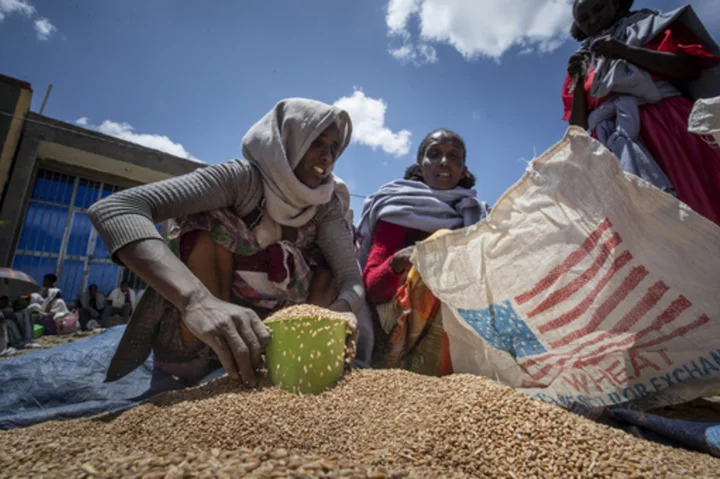As a child growing up in the Bay Area, Luis Aguirre’s weekend schedule was stacked. Each week, he’d visit the house of one of his 60-plus cousins, where the kids would play and the adults would enjoy some chisme.
“Every weekend was spent with each other. We’d all get together and we’d play, while my aunts and uncles hung out,” Aguirre tells Refinery29 Somos, adding that all the time he spent with his family growing up made him an extrovert. “Even if we were just chilling and watching a movie, to this day that makes me feel at home and feel loved.”
It’s no wonder then that Aguirre, a first-born, first-generation child of Mexican immigrants, internalized the idea that love means showing up for the people you care about.
His early notion of love was especially influenced by his mother, who raised him in a single-parent household.
“You could feel her love through the meals and through all the things she did for us. Through her, I learned that expressing love means taking action that shows ‘I’m here for you.'”
Luis Aguirre“I definitely got it from my mom, who worked really hard to put food on the table,” Aguirre says. “You could feel her love through the meals and through all the things she did for us. Through her, I learned that expressing love means taking action that shows, ‘I’m here for you.’”
It wasn’t until Aguirre started dating that his view of love as a service-oriented act was ever challenged. Through different experiences, he recognized that his partners may be more responsive to other ways of expressing love beyond the acts of service he grew up with and was accustomed to.
“Growing up, words of affirmation were not super common, so they still feel uncomfortable but good. Same thing with touch; you get it so sparingly as a kid,” Aguirre says. “For sure, acts of service were ingrained in me so I always took a nonverbal route, which was not great. I had to learn to be more emotional and be more vocal with how I’m actually feeling.”
Aguirre is not the only person who struggles with communicating their feelings, but according to Cristina Castrillón, a licensed marriage and family therapist, the children of Latine immigrants may struggle with words of affirmation and the other four love languages because their parents could have expressed love in different ways when they were growing up.
“The children of Latine immigrants may struggle with words of affirmation and the other four love languages because their parents could have expressed love in different ways when they were growing up.”
gwen aviles“There’s never a true catchall; the specifics of everyone’s experiences are nuanced,” Castrillón, whose Instagram post on this very topic has resonated with many, tells Somos. “But part of my motivation for making that post was to give clients the tools to conceptualize and apply to their own life and to navigate the different stages that might come up.”
The Five Love Languages: A Limited Western Framework
When Castrillón, who came to the United States from Colombia when she was four years old, began honing in on what she wanted to pursue for work, she quickly realized that many of the psychological concepts and frameworks she was learning were not created with immigrants in mind.
This included the 5 Love Languages, a concept popularized by author Gary Chapman in his 1992 book, The Five Love Languages: How to Express Heartfelt Commitment to Your Mate.
“There’s never a true catchall; the specifics of everyone’s experiences are nuanced.”
Cristina CastrillónThe book, which has sold more than 11 million copies in English and has been translated into 40-plus languages, outlines several ways of giving and receiving love, including acts of service, words of affirmation, gift-giving, physical touch, and quality time. Per Chapman, a person can discover their partner’s love language through observing what they ask for and learn to express care for them in their preferred “love language.” He also states that people tend to naturally express love in the ways they wish to receive it.
While widely accepted, this framework fails to account for immigrants, argues Castrillón.
In her post, she reworks the 5 Love Languages theory, examining it through the lens of what children of immigrants may have experienced growing up in order to enable them to “hold space to grieve the lack and ability of our parents, while celebrating our current work to learn to give and receive love in ways possible now and with future generations.”
As she explains, immigrant parents may not have seen words of affirmation or physical touch as necessary or appropriate, particularly as they could have been focused on surviving and addressing their family’s immediate needs. Similarly, she says that quality time and gift-giving are often considered luxuries for low-income immigrant parents, especially those who are undocumented and face increased barriers in employment. Finally, while acts of service may be the love language children of immigrants are most familiar with, for some even this one may have been restricted due to the time constraints of working parents and grandparents.
“We may have to be a little more understanding, and expect that our experiences in immigrant families might be different than portrayed around us.”
CRISTINA CASTRILLÓN“We have to understand the context because we can’t necessarily hold immigrant parents to that same norm,” Castrillón says. “We may have to be a little more understanding, and expect that our experiences in immigrant families might be different than portrayed around us.”
Navigating Different Love Languages and Understanding How We Love
Even when both partners in a relationship are Latine, whether they’re first- or second-generation, there may be differences in the ways they give and receive love.
Yadira Flores first encountered the idea of the 5 love languages in college, but it wasn’t until entering her most recent relationship that she began to more deeply reflect on how her upbringing may have affected the way she gives and receives love.
“My partner, who wasn’t raised directly by an immigrant and is second generation, caused me to reflect on why there were so many parallels between the way I grew up and the ways I express love as an adult,” Flores, whose parents both emigrated from Mexico, told Somos.
After her partner brought up struggling with the lack of words of affirmation in their relationship, Flores recognized that this love language along with physical touch were difficult for her to express — something she particularly attributes to both of her parents coming from large families with at least 10 other siblings where there wasn’t always enough attention or “love to go around.”
“My partner, who wasn’t raised directly by an immigrant and is second generation, caused me to reflect on why there were so many parallels between the way I grew up and the ways I express love as an adult.”
Yadira Flores“When it comes to relationships, communication is important. Otherwise, there can be a disconnect and problems can arise from that,” Flores tells Somos. “We may have different ways of showing love — for me, cleaning as an act of service is one way. But since talking to my partner, I’ve been trying to say words of affirmation more often. At first it’s uncomfortable, but it’s becoming more natural.”
For Genny Velasco, a first-generation Salvadoran, it’s been critical to attend therapy, accept that not everyone has the same “emotional needs and wants as you have,” and practice patience with herself and others.
“To anyone who was in a similar situation where they didn’t receive love and support while growing up, faced significant challenges, took on responsibilities, witnessed financial struggles, and felt unloved with unmet needs: Remember that it wasn’t your fault. Don’t be afraid to seek support from trusted individuals,” Velasco says. “Embrace self-compassion and remember that you don’t need external validation to know that you are valued, important, and loved. You don’t need to carry the weight of the whole world on your shoulders.”
The Benefits of Learning New Ways to Love
Knowledge about the 5 love languages has potential benefits beyond strengthening romantic relationships, too. According to Corina Zarate, an Austin, Texas-based art director, the relational skill of clear communication translates over into other areas of life, including work, friendships, and family.
When Zarate moved after college, she realized she didn’t have the resources she needed to navigate post-grad life. She also found that keeping in touch with friends and showing love and care for them when they were living apart was difficult.
This is why she developed a card game called Remember Me, which is aimed at sparking meaningful conversations among friends and family.
“Vulnerability actually takes a lot of courage, and building community and relationships is worth the vulnerability it requires.”
Corina Zarate“A lot of people see vulnerability as a weakness, especially in Mexico,” Zarate says, adding that growing up she struggled to express her emotions. “But vulnerability actually takes a lot of courage, and building community and relationships is worth the vulnerability it requires.”
As for Aguirre, he still isn’t sure what his favorite love language is; ideally, he gets a bit of all of them. But one thing he’s confident in is that continuing on this journey of understanding how he best gives and receives love is something he has to do —- not only for himself, but for his daughter.
“If you want to grow, you have to rebel against the machismo,” Aguirre said. “We think of men as fitting a certain type of profile, and of being stoic and hardworking, and we need to understand men have emotions, too. We need to talk about it and not take it out on our kids. … We bottle things up too much as a culture and suffer in silence.”
“Giving and receiving love makes us feel alive. It gives us some purpose in our lives.”
CRISTINA CASTRILLÓNFrom healing family trauma to enabling us to experience joy, understanding how we give and receive love can be life-changing, Castrillón says.
“Giving and receiving love makes us feel alive. It gives us some purpose in our lives,” Castrillón adds. “We obtain trauma via relationships, but we can also heal via relationships. Things may have been hard, but try to keep an open mind and heart and don’t shut down.”









